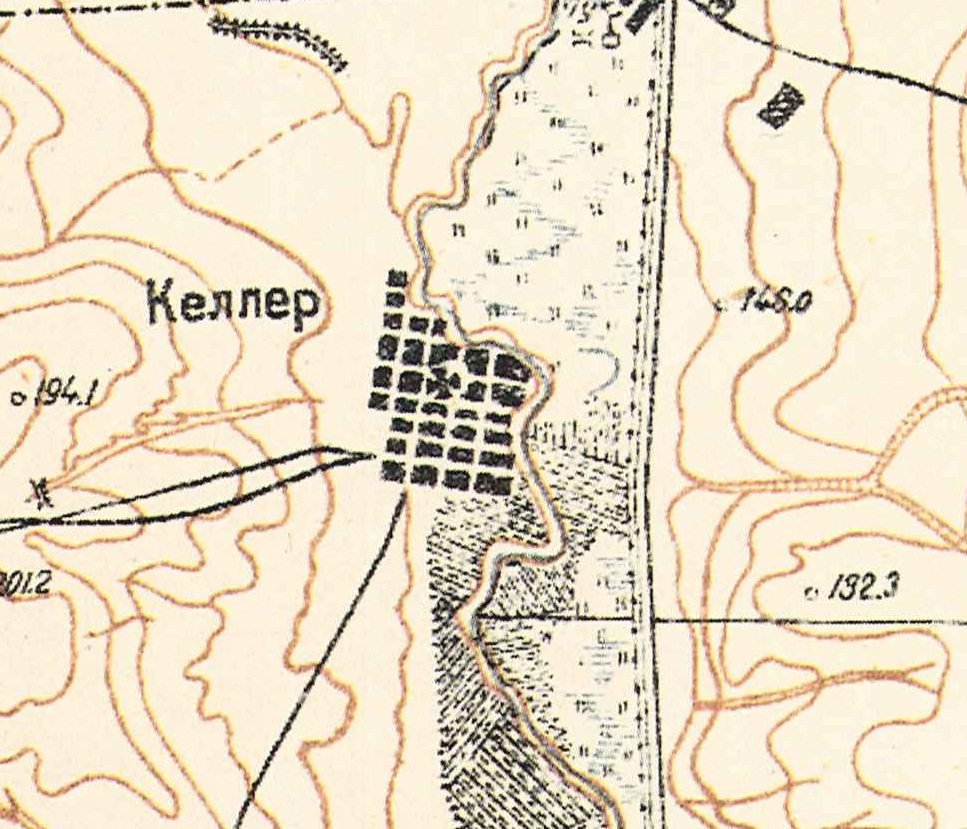The congregation in Köhler was originally part of the Semenovka Parish, later becoming independent. The original church structure was replaced in 1864 by a wooden church with a metal roof, built in the neo-classical "Kontor" style and dedicated to St. Michael Archangel. Pilgrims would visit the chapel in Köhler in honor of "Discovery of the Cross." Three priests were buried in the parish cemetery.
The following Priests served the village of Köhler,
Philipp Becker (1893-1895)
Josef Hein (1897)
Adolf Ulrich (1897-1901)
Ferdinand Hirsch (1901-1905)
Nikolaus Maier (1905-1913)
Florian Schulz (1914)
Josef Veith (1915)
Köhler was founded on 10 August 1767 by the Government as a Roman Catholic colony on the left bank of the Ilovlya River below the confluence of the Karaulny Buyerak. The colony's Russian name (Karaulny Buyerak) was taken from this nearby river. The original colonists came from Fulda, Würzburg, and Mainz. Minkh reports that the came from Bavaria, the Rhein provinces of Elsass, and Lotharingia.
There was a parochial school in Köhler, founded at the same time as the colony. In 1884, a governmental district school was constructed in the colony.
According to Minkh, in 1887 the colony had 1 cooper, 5 blacksmiths, 13 wheelwrights, 2 stove-setters, 4 carpenters, 1 chenille maker, 6 cloth weavers, 4 woodworkers, and 17 shoemakers.
Minkh reports that in 1861, 1864, and 1872, a total of 11 families relocated to daughter colonies on the Wiesenseite. In 1870 and 1874, 17 families resettled to the colonies in the North Caucasus. In 1877, 33 families immigrated to North America & Argentina followed by an additional 25 families in 1886. From 1875 to 1880, a number of colonists also relocated to Siberia.
|
Year
|
Households
|
Population
|
||
|---|---|---|---|---|
|
Total
|
Male
|
Female
|
||
| 1767 |
95
|
282
|
151
|
131
|
| 1769 |
86
|
289
|
155
|
134
|
| 1773 |
84
|
368
|
201
|
167
|
| 1788 |
84
|
511
|
259
|
252
|
| 1798 |
92
|
616
|
303
|
313
|
| 1816 |
134
|
901
|
455
|
446
|
| 1834 |
193
|
1,583
|
793
|
790
|
| 1850 |
269
|
2,182
|
1,095
|
1,087
|
| 1857 |
256
|
2,396
|
1,204
|
1,192
|
| 1859 |
|
2,324
|
|
|
| 1860 |
219
|
2,394
|
1,199
|
1,195
|
| 1886 |
384
|
2,996
|
1,550
|
1,446
|
| 1891 |
367
|
3,124
|
1,935
|
1,189
|
| 1894 |
374
|
3,768
|
1,993
|
1,775
|
| 1897 |
|
3,127*
|
1,612
|
1,515
|
| 1905 |
|
5,017
|
|
|
| 1911 |
|
6,091
|
|
|
| 1912 |
|
5,970
|
|
|
| 1920 |
566**
|
3,847
|
|
|
| 1922 |
|
2,358
|
|
|
| 1923 |
|
2,736
|
|
|
| 1926*** |
556
|
3,024
|
1,502
|
1,522
|
| 1931 |
|
3,387****
|
|
|
*Of whom 3,123 were German.
**Of which 564 households were German.
***Of whom 3,023 were German (555 households: 1,501 male & 1,522 female).
****Of whom 3,385 were German.
Beratz, Gottieb. The German colonies on the Lower Volga, their origin and early development: a memorial for the 150th anniversary of the arrival of the first German settlers on the Volga, 29 June 1764 . Translated by Adam Giesinger (Lincoln, NE: American Historical Society of Germans from Russia, 1991): 350.
Diesendorf, V.F. Die Deutschen Russlands : Siedlungen und Siedlungsgebiete : Lexicon. Moscow, 2006.
Dietz, Jacob E. History of the Volga German Colonists . Lincoln, NE: American Historical Society of Germans from Russia, 2005.
Klaus, A.A. Our Colonies . Saint Petersburg, Russia, 1869.
Minkh, A.N. Historical and Geographical Dictionary of the Saratov Province (Saratov, Russia, 1898): 474-477. ( Online )
Pallas, P.S. Reise durch verschiedene Provinzen des Russischen Reichs. Theil 3,2, Reise aus Sibirien zurueck an die Wolga im 1773sten Jahr (St. Petersburg: Kaiserl. Academie der Wissenschaften, 1776): 623.
Preliminary Results of the Soviet Census of 1926 on the Volga German Autonomous Soviet Socialist Republic (Pokrovsk, 1927): 28-83.
Schnurr, Joseph, Die Kirchen und das Religiöse Leben der Russlanddeutschen - Katholischer Teil (Stuttgart: Selbstverlag Joseph Schnurr, 1980): 257.
"Settlements in the 1897 Census." Journal of the American Historical Society of Germans from Russia (Winter, 1990): 18.
Keller (wolgadeutsche.net) - in Russian
